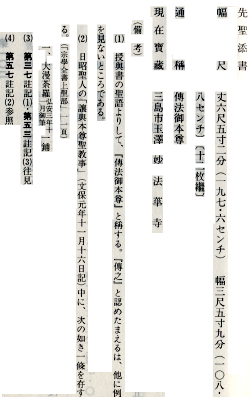
Nichiren Shonin
Gohonzon Shu

O'Mandalas by St. Nichiren
[1222-1282]

 |
Nichiren Shonin |  |
|
The ultimate teaching of the Lotus Sutra is the original inherence of the ten realms. When you face this object of worship, the realm of oneself, the realm of the Buddha, and the realm of living beings are all the essence of the Wonderful Dharma, the suchness which is original enlightenment....Such readings are on the one hand rooted in Nichiren's treatise Kanjin honzon sho, which discussed the object of worship as embodying the mutual inclusion of the ten realms and the importance of believing that one's own deluded thought-moment contains the Buddha realm. However, there is also strong evidence of medieval Tendai thought, in the privileging of the ordinary worldling over the Buddha who appeared in this world--something rarely found in Nichiren's authenticated writings. As noted earlier, it was often the immanentalist side of Nichiren's doctrine that most engaged his Muromachi period successors, who also drew on medieval Tendai conventions in interpreting it. The second quotation immediately above, for example, represents an instance of the reversals common in Tendai kanjin-style readings informed by notions of original enlightenment: The Buddha depicted in the sutra is dismissed as a mere provisional Buddha, while the ordinary worldling is identified as the true Buddha.
Now [in our school, we] do not establish contemplation [as the method of realizing the three thousand realms in one thought-moment]. We display it on a sheet of paper, so that one can directly see, in a single thought-moment, three thousand realms.
What is the true inclusion of the ten realms? The teacher [Nichiren] said: "The seven characters that are chanted are the Buddha realm. We who chant them are the nine realms. When the cause and effect of the four teachings are demolished, the true cause and effect of the ten realms is revealed." At the same time, we are the unproduced triple-bodied [Tathagata], the true Buddha (jitsubutsu), who dwells in the Land of Tranquil Light. The Buddha who appeared in this world was a manifested trace (suijaku), a provisional Buddha who benefits the beings through provisional teachings. Keep this secret! Keep this secret!
The explanation below refers to Mandalas
#37, #53 and #57. |
 |
 |
![]()
![]()
Gohonzonsh¯u (129 halographs)
|

|
|
Worldwide Directory | Site Map | Advertising | Buddhas | Discuss | Gohonzon | Gosho | Fuju_Fuse | Honmon_Butsuryu | Independents | Kishimojin | Lotus_Sutra | Mikkyo | Miraculous_Tales | Nichiren | Nipponzan | Nichiren_Shoshu | Nichiren_Shu | Pilgrimage | Prayer | Pure_Land | Queers | Reiyukai | Rissho_Koseikai | Soka_Gakkai | Stupas | Sutra_Library | Tendai | Theravada | WebRings | Women | Misc. | BuddhistInmates.net | Dharma-House.org | Ryuei.net | Sivartha's_Mind_Maps |
![]()
![]()
| ||||
| ||||
| ||||